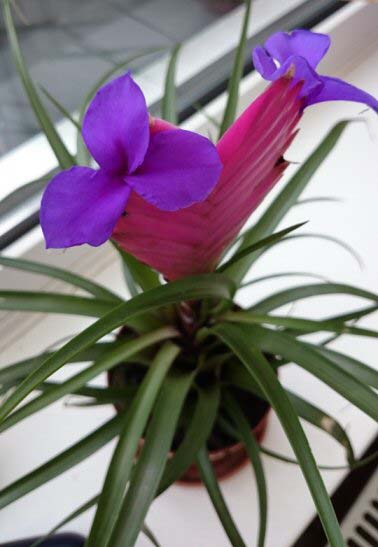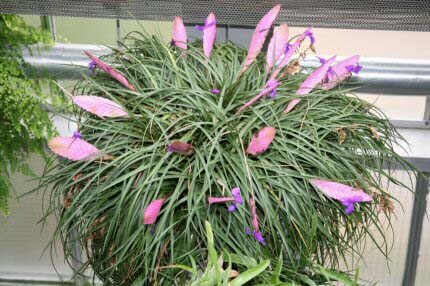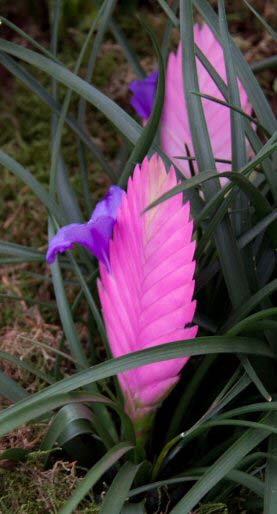





The are several plants from the Tillandsia Genus grown as houseplants. You have the popular gray Air Plants (which we will write an article soon) and the subjects of this article:  The Blue Flowered Torch or Pink Quill Plant - Otherwise known as Tillandsia cyanea or Tillandsia lindenii. We've put the gray Tillandsia Air Plants into another article because the care requirements are very different to the green Tillandsia's, plus in general the two plants look very different.
The Blue Flowered Torch or Pink Quill Plant - Otherwise known as Tillandsia cyanea or Tillandsia lindenii. We've put the gray Tillandsia Air Plants into another article because the care requirements are very different to the green Tillandsia's, plus in general the two plants look very different.
The gray Tillandsia Air Plants can look quite dull, where as the Pink Quill looks very vibrate with a bright pink flowering bract that resembles an old fashioned quill.
Like the Urn Plant, the Pink Quill plant is also a Bromeliad which is desirable because of the exotic and tropical looking flowering bract that it produces. Lasting up to 3 months they can really add interest to an area much longer than a bunch of flowers could. There is no repeat flowering with many Bromeliads instead they live on either through the seeds they create (not a viable option for the average owner), or by the offsets the mature plant produces after flowering has finished. This means the Pink Quill plant is frequently treated as pot plants, or as a temporary house guest. That said the stiff green leaves can have a beauty of their own that people will find attractive.
Like most of the popular Bromeliad houseplants, once flowering is finished the flowering bract of the Pink Quill plant starts to die, followed by the main adult. With its energy exhausted it has once last trick which is to produce several offsets around its base - the next generation. These offsets or "pups" can be separated from the parent plant if desired and grown on to hopefully flower themselves one day, or you can leave them where they are.  In time this will produce an attractive large bush which could have multiple flowering bracts as shown in the picture below.
In time this will produce an attractive large bush which could have multiple flowering bracts as shown in the picture below.
It's rewarding to grow a young offset to the flowering stage although it's still much more common to purchase a flower already in bloom.
The Pink Quill Plants are quite cheap to purchase considering and they are great modern staple houseplants to find in supermarkets or superstores because they need little fuss from the often novice shop assistants. It's unlikely you will find them correctly marked as "Tillandsia", but you will only really ever find one of two Pink Quills, either T. cyanea or T. lindenii. They look very similar the only real difference is that T. lindenii has a taller flowering stalk.
Light
You need to avoid direct sunlight to prevent the leaves burning, but good indirect light is needed to quickly grow young plants to a flowering size. However if your plant is already in flower or you do not intend to keep your Pink Quill around after flowering has finished then less light is fine.
Your Pink Quill doesn't need as much water as a typical houseplant but you should be looking to water whenever the soil dries out.
Watering
The majority of plants belonging to the Tillandsia genus such as the Air Plants don't need much water, however the Pink Quill does need quite a bit more to do really well. They can be chlorine sensitive so if you are able, provide rain or bottled water instead of tap water.
It doesn't need as much watering as a typical houseplant but you should be looking to water whenever the soil becomes dry. This may mean a good watering every couple of weeks, more in very hot weather and less in Winter. When in doubt its better to underwater than overwater these plants.
Humidity
If humidity is low your Tillandsia will appreciate a misting of its leaves occasionally during warm months. It's not overly important however in average room conditions, so if you choose not to mist your plant shouldn't suffer any ill effects.
Feeding
Two feeds a year at standard strength is plenty. Once in early Spring and again in late Summer. You can feed the soil directly like you would most houseplants, or put the solution into a mister and apply it to the leaves.
Temperature
Most Bromeliads prefer warm conditions and you may have to provide a temperature for plants on the verge of flowering of around 24°C / 75°F to get that flowering bract to appear. But they're not especially fussy about temperature once they are in flower or very young. Average room temperatures will be fine.
Repotting
If you buy a Tillandsia already in flower there will be no need to repot at all. If you are growing on a young offset however, repot and upsize the pot each spring if the roots have filled the pot. Don't be concerned if this doesn't happen as the roots of the Pink Quill plant are very basic and compact. It's important there is at least a small amount of space for new roots to grow into and if there still is, don't bother repotting. The potting mix you choose must be free draining i.e. standard potting compost mixed with a little grit or perlite will do the job perfectly well.
Propagation
As the adult plant starts to end it's flowering cycle, offsets will appear around the base. Once the flowering bract and the adult plant starts to decline you can either remove the offsets, trying to retain some of their roots, or leave things as they are. If you do decide to remove the offsets, pot up into a small pot, providing good light and keep the soil moist. If you have left the offsets where they are growing, in time you will create a sort of "colony" with lots of Pink Quill plants growing close together. Just be sure there is space for them to be able to spread, if there isn't repot into a wider pot.
Speed of Growth
Tillandsia is quite a small plant once fully grown, and seeing as it takes two to three years for a young offset to reach flowering size potential the plant does grow quite quickly for its size. Although in relative terms because the end size is quite petit they might not appear to grow very fast at all.
Height / Spread
Including the flowering bract the final height (of a mature plant) will be no more then 25cm / 10in and the spread 20cm / 8in.  Clearly if you allow multiple offsets to grow in situ then the spread will be much wider after many years.
Clearly if you allow multiple offsets to grow in situ then the spread will be much wider after many years.
Flowers
There are many blue, purple or pink flowers that appear on the sides of the flowering bract. The Pink Quill will only have one or two of its dainty flowers open at any one time and they are very short lived, perhaps only staying open for a few days at most.
Ultimately it's the flowering bract which is the attraction to these plants, quill shaped and often bright pink, it waves around looking almost alien like and easily draws the eye. The flowering bract can last up to 6 months although the colours may fade somewhat over time to become green. It's usual to buy these Tillandsia already at flowering stage, however if you are growing a young plant on, you can expect them to appear once it's about three or four years old.
Anything else?
Despite it's tropical appearance this is quite a hardy and easy plant to care for so they make great gifts, especially for a writer friend (because of the Quill / pen link). However do be careful of very cheap "bargains" because the seller knows when the flowering bract starts to wane the main selling point is about to be lost, as the tough leaves by themselves are dull in comparison.
Copyright © www.100flowers.win Botanic Garden All Rights Reserved